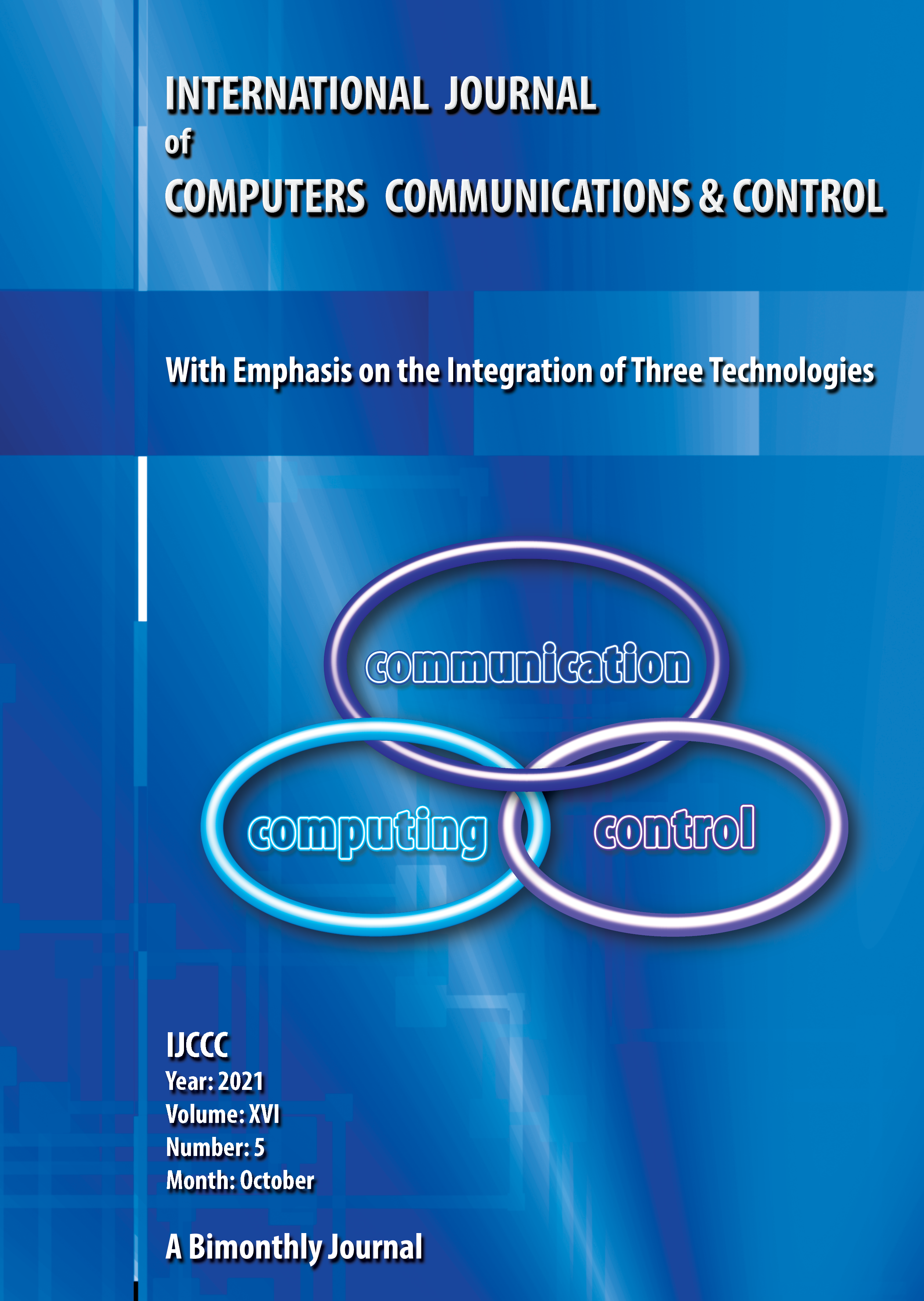Multi Objective PSO with Passive Congregation for Load Balancing Problem
Keywords:
high-level architecture, load balancing, particle swarm optimization, crowding distance, passive congregation, MOPSO-CD-PCAbstract
High-level architecture (HLA) and Distributed Interactive Simulation (DIS) are commonly used for the distributed system. However, HLA suffers from a resource allocation problem and to solve this issue, optimization of load balancing is required. Efficient load balancing can minimize the simulation time of HLA and this optimization can be done using the multi-objective evolutionary algorithms (MOEA). Multi-Objective Particle Swarm Optimization (MOPSO) based on crowding distance (CD) is a popular MOEA method used to balance HLA load. In this research, the efficiency of MOPSO-CD is further improved by introducing the passive congregation (PC) method. Several simulation tests are done on this improved MOPSO-CD-PC method and the results showed that in terms of Coverage, Spacing, Non-dominated solutions and Inverted generational distance metrics, the MOPSO-CD-PC performed better than the previous MOPSO-CD algorithm. Hence, it can be a useful tool to optimize the load balancing problem in HLA.
References
[2] Ding, S.; Chen, C.; Xin, B.; Pardalos, P.M. (2018). A bi-objective load balancing model in a distributed simulation system using NSGA-II and MOPSO approaches, Applied Soft Computing, 63(C), 249-267, 2018. https://doi.org/10.1016/j.asoc.2017.09.012
[3] Ficco, M.; Avolio, G.; Palmieri, F.; Castiglione, A. (2016). An HLA-based framework for simulation of large-scale critical systems, Concurrency and Computation: Practice and Experience, 28(2), 400-419, 2016. https://doi.org/10.1002/cpe.3472
[4] Hossain,M. S.; Sidek,L. M.; Marufuzzaman,M.; Zawawi,M. H. (2018). Passive congregation theory for particle swarm optimization (PSO): An application in reservoir system operation, International Journal of Engineering and Technology (UAE), 7(4:35), 383-387, 2018. https://doi.org/10.14419/ijet.v7i4.35.22767
[5] Li, L.; Wang, W.; Li, W.; Xu, X.; Zhao, Y. (2016). A novel ranking-based optimal guides selection strategy in MOPSO, Procedia Computer Science, 91, 1001-1010, 2016. https://doi.org/10.1016/j.procs.2016.07.135
[6] Marufuzzaman M.; Reaz M.B.I.; Ali M.A.M.; Rahman L.F. (2015). A time series based sequence prediction algorithm to detect activities of daily living in smart home, Methods of information in medicine, 54(3), 262-270, 2015. https://doi.org/10.3414/ME14-01-0061
[7] Marufuzzaman M.; Reaz M.B.I.; Rahman L.F.; Farayez A.A. (2015). A Location Based Sequence Prediction Algorithm for Determining Next Activity in Smart Home, Journal of Engineering Science & Technology Review, 10(2), 161-165, 2017. https://doi.org/10.25103/jestr.102.19
[8] Marufuzzaman, M.; Al Karim, S.; Rahman, M. S.; Zahid, N. M.; Sidek, L. M. (2019). A review on reliability, security and memory management of numerous operating systems, Indonesian Journal of Electrical Engineering and Informatics, 7(3), 577-585, 2019. https://doi.org/10.11591/ijeei.v7i3.987
[9] Mishra, S. K.; Panda, G.; Majhi, R.; (2014). A comparative performance assessment of a set of multiobjective algorithms for constrained portfolio assets selection, Swarm and Evolutionary Computation, 16, 38-51, 2014. https://doi.org/10.1016/j.swevo.2014.01.001
[10] Nasonov, D.; Butakov, N.; Melnik, M.; Visheratin, A.; Linev, A.; Shvets, P.; Sobolev, S.; Mukhina, K. (2018). The multi-level adaptive approach for efficient execution of multi-scale distributed applications with dynamic workload, In: Voevodin V., Sobolev S. (eds) Supercomputing. RuSCDays 2018. Communications in Computer and Information Science, 965, Springer, Cham. 600-611, 2018. https://doi.org/10.1007/978-3-030-05807-4_58
[11] Patel, D.K.; Tripathy, D.; Tripathy, C.R.(2016). Survey of load balancing techniques for Grids, Journal of Network and Computer Applications, 65(2016), 103-109, 2016. https://doi.org/10.1016/j.jnca.2016.02.012
[12] Silva, T.WB.; Morais, D.C.; Andrade, H.G.R.; Lima, A.M.N.; Melcher, E.U.K.; Brito, A.V. (2018). Environment for integration of distributed heterogeneous computing systems, Journal of Internet Services and Applica, 9(4), 1-17, 2018. https://doi.org/10.1186/s13174-017-0072-1
[13] Souravlas, S. (2019). ProMo: A Probabilistic Model for Dynamic Load-Balanced Scheduling of Data Flows in Cloud Systems, Electronics, 8(990), 1-15, 2019. https://doi.org/10.3390/electronics8090990
[14] Xu, X.; Hu, Z.; Su, Q.; Xiong, Z. (2018). Multi-objective Collective Decision Optimization Algorithm for Economic Emission Dispatch Problem, Complexity, 2018(1027193), 1-20, 2018. https://doi.org/10.1155/2018/1027193
[15] Zhou, A.; Qu, B.Y.; Li, H.; Zhao, S.Z.; Suganthan, P.N.; Zhang, Q. (2011). Multi-objective evolutionary algorithms: A survey of the state of the art, Swarm and Evolutionary Computation, 1, 32-49, 2011. https://doi.org/10.1016/j.swevo.2011.03.001
[16] Zitzler, E.; Thiele, L. (1998). Multiobjective optimization using evolutionary algorithms - a comparative case study, In International conference on parallel problem solving from nature, 292-301, Springer, Berlin, 1998. https://doi.org/10.1007/BFb0056872
Additional Files
Published
Issue
Section
License
ONLINE OPEN ACCES: Acces to full text of each article and each issue are allowed for free in respect of Attribution-NonCommercial 4.0 International (CC BY-NC 4.0.
You are free to:
-Share: copy and redistribute the material in any medium or format;
-Adapt: remix, transform, and build upon the material.
The licensor cannot revoke these freedoms as long as you follow the license terms.
DISCLAIMER: The author(s) of each article appearing in International Journal of Computers Communications & Control is/are solely responsible for the content thereof; the publication of an article shall not constitute or be deemed to constitute any representation by the Editors or Agora University Press that the data presented therein are original, correct or sufficient to support the conclusions reached or that the experiment design or methodology is adequate.








